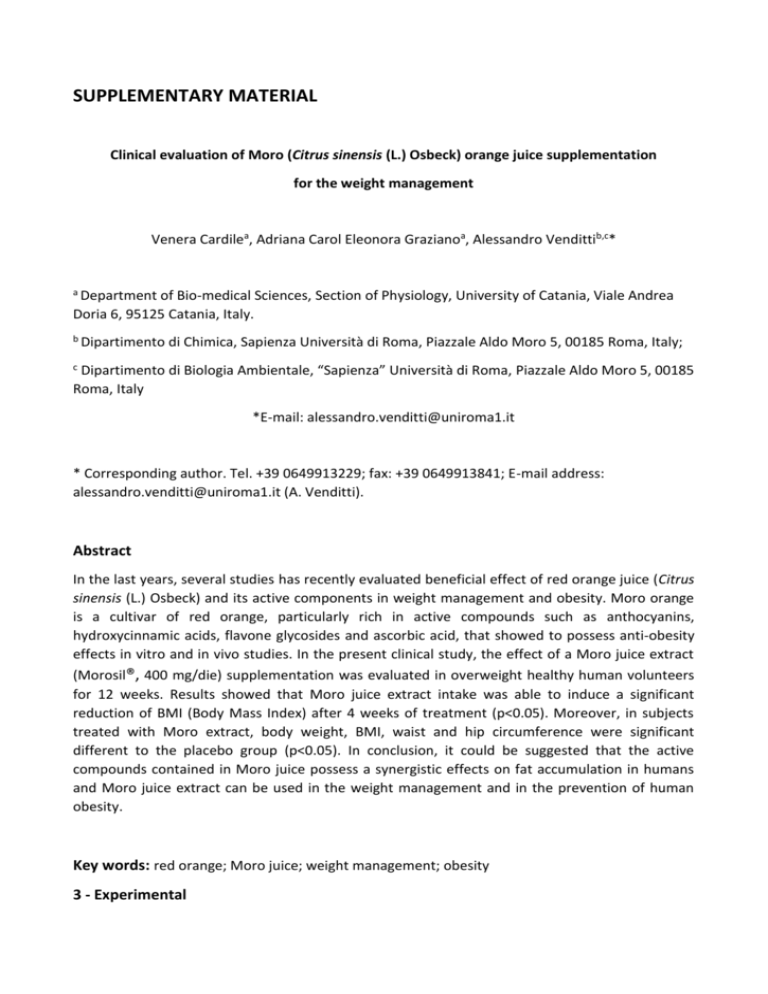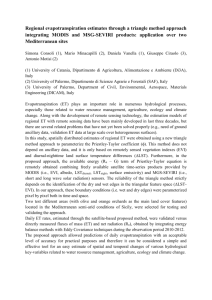supplementary material
advertisement

SUPPLEMENTARY MATERIAL Clinical evaluation of Moro (Citrus sinensis (L.) Osbeck) orange juice supplementation for the weight management Venera Cardilea, Adriana Carol Eleonora Grazianoa, Alessandro Vendittib,c* a Department of Bio-medical Sciences, Section of Physiology, University of Catania, Viale Andrea Doria 6, 95125 Catania, Italy. b Dipartimento di Chimica, Sapienza Università di Roma, Piazzale Aldo Moro 5, 00185 Roma, Italy; c Dipartimento di Biologia Ambientale, “Sapienza” Università di Roma, Piazzale Aldo Moro 5, 00185 Roma, Italy *E-mail: alessandro.venditti@uniroma1.it * Corresponding author. Tel. +39 0649913229; fax: +39 0649913841; E-mail address: alessandro.venditti@uniroma1.it (A. Venditti). Abstract In the last years, several studies has recently evaluated beneficial effect of red orange juice (Citrus sinensis (L.) Osbeck) and its active components in weight management and obesity. Moro orange is a cultivar of red orange, particularly rich in active compounds such as anthocyanins, hydroxycinnamic acids, flavone glycosides and ascorbic acid, that showed to possess anti-obesity effects in vitro and in vivo studies. In the present clinical study, the effect of a Moro juice extract (Morosil®, 400 mg/die) supplementation was evaluated in overweight healthy human volunteers for 12 weeks. Results showed that Moro juice extract intake was able to induce a significant reduction of BMI (Body Mass Index) after 4 weeks of treatment (p<0.05). Moreover, in subjects treated with Moro extract, body weight, BMI, waist and hip circumference were significant different to the placebo group (p<0.05). In conclusion, it could be suggested that the active compounds contained in Moro juice possess a synergistic effects on fat accumulation in humans and Moro juice extract can be used in the weight management and in the prevention of human obesity. Key words: red orange; Moro juice; weight management; obesity 3 - Experimental 3.1 Reagents and test material The powder extract of Moro red orange variety (Morosil® batch 02201306-10) used in this study was supplied by Bionap srl (Catania, Italy). It is a standardized solid extract obtained from Moro orange fruits, containing the following active substances: anthocyanins (cyanidin-3-O-glucoside) 0.8-0.9%, hydroxycinnamic acids (caffeic, cumaric, ferulic, sinapic acid) 2-2.2%, flavone glycosides (narirutin, hesperidin) 0.8-1% and ascorbic acid 4.3-4.5%. All the standard compounds and the reagents for analytical evaluation were supplied from Extrasynthese (Lyon, France) and SigmaAldrich (Milan, Italy). Tablets containing 400 mg of Morosil® extract or 400 mg of maltodextrin were prepared for the in vivo study. 3.2 Polyphenols analysis of Moro orange extract Active compounds contained in Moro orange extract were analysed using a Shimadzu HPLC system (Kyoto, Japan) equipped with an SCL-10Avp controller, two LC-10ADvp pumps, a DGU-14A degasser, and an SPD-M10vp diode array detector. The column used was an Ascentis C18 (25cm x 4.6 mm x 5 µm) column purchased from Sigma-Aldrich. Hydroxycinnamic acids were analysed by the HPLC method reported by Rapisarda et al (Rapisarda, 1998). Chromatograms were recorded with a 300 nm UV light and isocratic elution was performed with a solvent mixture of 18% tetrahydrofuran and 82% water-acetic acid solvent system. Caffeic, cumaric, ferulic and sinapic acid obtained from Extrasynthese (France) were used as external standards. For flavone glycosides contained in the extract a solvent system contained water/acetonitrile/acetic acid 79.5:0.5:20 (v/v/v) was used for a run time of 25 minutes at 280 nm UV-light. External standards (narirutin, hesperidin) purchased from Extrasynthese (France) were used as external standard. Finally, an isocratic solvent system contained methanol 0.1% orthophosphoric acid and at 245 nm UV-light was used to detect ascorbic acid contained in the extract. Anthocyanins class compounds were identify using a UV-spectrophotometric method (UV-1700, PharmaSpec, Shimadzu). Moro extract was solubilized in a 1% HCl methanol solution and, afterwards, Moro extract solution was diluted with a pH=3 buffer solution (citric acid/sodium phosphate dibasic). Anthocyanins were detected at 520 nm and identified by using cyanidin-3-glucoside chloride (Extrasynthese, France) as external standard. 3.3 Human clinical study 3.3.1 Subjects A randomized, placebo, double blinded clinical trial was performed on 60 healthy volunteers (aged 21-50 years old), recruited after medical screening including the completion of a health questionnaire followed by physical examination. Inclusion criteria was: a body mass index (BMI) between 25-35 Kg/m2, not taking any drugs or dietary food supplement during the experimentation. Moreover, volunteers maintained their previous daily physical exercise and eating habits (1500-2000 cal/day) without any particular changes or dietetic program during the clinical study. Excluding criteria was: pregnancy, smokers, having a history of thyroid disease, cardiovascular disease, diabetes, using weight loss medications, laxative or diuretic, recent unexplained weight loss or gain, taking medications during the previous months (including vitamin and antioxidant supplement) or any significant dysfunctions. After pre-inclusion, volunteers were fully informed of the nature of the study, substances and procedures involved, they gave their written informed consent before participation. 3.3.2 Treatment protocol The volunteers were assigned by randomization into two groups of 30 peoples. The placebo group received a dietary supplement of one tablet per day, between meals, containing 400 mg of maltodextrin while the MoroEx group received one tablet per day, between meals, containing 400 mg of Moro juice extract. During the clinical trial, subjects were evaluated at the beginning of the study (T0), after 2 weeks (T1), 4 weeks (T2), 8 weeks (T3) and 12 weeks (T4) of treatment. At each time point, subjects were monitored for several anthropomorphic parameters such as body weight and body mass index (BMI); waist circumference and hip circumference were monitoring at the beginning and the end-point of the study. Vital signs such as blood pressure were measured to monitored the general health of the subjects and any side effects observed were recorded during each visit. 3.3.4 Statistical analysis All data obtained were submitted to a statistical analysis. All statistical comparisons in data were evaluated using Kruskal-Wallis test and difference between groups were tested using the MannWhitney U test. A p value of less than 0.05 was considered significant. Reference. Rapisarda P, Carollo G, Fallico B, Tomaselli F, Maccarone E. 1998. Hydroxycinnamic Acids as Markers of Italian Blood Orange Juices. J. Agric. Food Chem. 46: 464-470.

